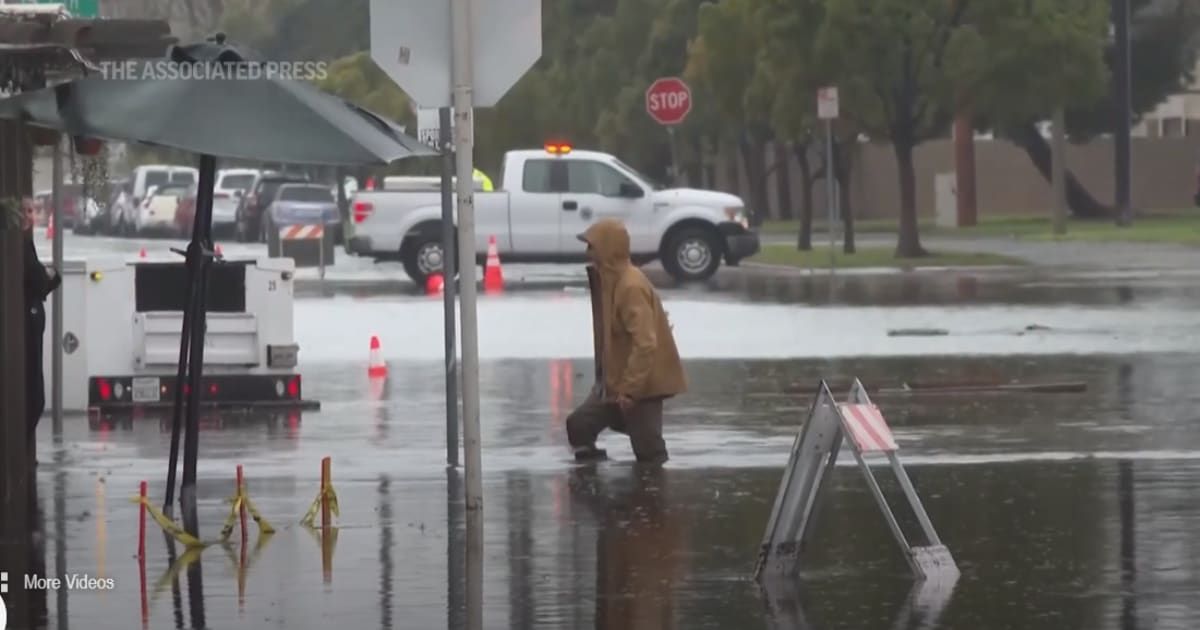Atmospheric river Pineapple Express triggers storms and flooding across California

LOS ANGELES, CALIFORNIA: The state of California was engulfed by a torrential downpour as the Pineapple Express, the first in a series of atmospheric rivers, swept across the region on Thursday, February 1.
The heavy rain reportedly caused extensive flooding on roads, while the mountains received a substantial amount of much-needed snow, reported Associated Press.
Initially hitting the San Francisco Bay Area on Wednesday and causing disruptions to cable car services, the storm then shifted its attention to the southern and eastern parts of the state.
The morning commute in Southern California was particularly affected by the downpours on Thursday.
The Pineapple Express continues to drive storms and floods, leaving the state struggling to brace its effects.
Full evolution of the Pineapple Express moving into California and the associated massive mid-latitude cyclone spinning off the West Coast.
— Colin McCarthy (@US_Stormwatch) February 1, 2024
Weather is awesome. pic.twitter.com/wTRqeSJmpV
What is the atmospheric river?
An atmospheric river, a lengthy band of moisture originating over the Pacific, is the driving force behind the storms inundating areas of Los Angeles and San Diego, according to National Weather Service forecaster Bob Oravec.
He explained that atmospheric rivers "typically occur ahead of cold fronts across the Pacific". He added, "And when they interact with the West Coast topography, you often get some very heavy rain both along the coastal ranges and also inland through the Sierras."
Atmospheric rivers are essentially elongated regions in the atmosphere, akin to "rivers in the sky" responsible for transporting the majority of water vapor outside the tropics. These atmospheric rivers can greatly differ in size and intensity.
On average, an atmospheric river carries a volume of water vapor roughly equivalent to the average water flow at the mouth of the Mississippi River.
Exceptionally potent atmospheric rivers can reportedly transport up to 15 times this amount. Upon making landfall, these atmospheric rivers often discharge this water vapor as rain or snow, as stated by NOAA.Gov.
San Diego resident clears storm drains amid heavy rainfall
Amid a downpour in San Diego, Ruben Gomez was busy clearing storm drains in his parents' neighborhood on Thursday.
He arranged sandbags around the remnants of their home, severely affected by flooding from a previous storm.
His parents, both aged 82, had to be rescued by firefighters from their waterlogged home, which had been inundated with water up to six feet high (2 meters) during the earlier storm.
His father was admitted to the hospital for two days due to hypothermia, while his mother was hospitalized for a week after water entered one of her lungs.
"Every hole in the house, I've got plugged with plastic and paper to make sure water doesn’t go up so high again," he shared, per AP News.
The patient was assessed and transported to the hospital in stable condition.
— OCFA PIO (@OCFireAuthority) February 1, 2024
As you can see, with the heavy rain, the channels are going to fill up quickly with the water moving at a dangerous speed. Please stay clear of bodies of water. pic.twitter.com/T4wdNTLz0k
What is the Pineapple Express?
The Pineapple Express, a well-known example of a potent atmospheric river, forms when moisture accumulates in the tropical Pacific near Hawaii, leading to heavy rainfall and snow on the West Coasts of the US and Canada.
This "river" is formed when prevailing winds pass over warm tropical water vapor bands and traverse the Pacific as part of the global conveyor belt.
Upon reaching the west coast, the Pineapple Express can unleash up to five inches of rain on California in a single day. Atmospheric rivers vary in size and strength, but those carrying the most water vapor and exhibiting the strongest winds can cause extreme rainfall and subsequent flooding.
The current Pineapple Express, is reportedly predicted to be followed by an even stronger storm on Sunday, according to forecasters.
Swift rescue teams are making access to a person that’s in the water and a storm channel. pic.twitter.com/XU5JLJQPPC
— OCFA PIO (@OCFireAuthority) February 1, 2024
Pineapple Express poses significant threat to Californians
In response, the California Governor's Office of Emergency Services has activated its operations center and deployed personnel and equipment to the areas at greatest risk.
Brian Ferguson, the deputy director of crisis communications for the Governor's Office, has warned of a "significant threat to the safety of Californians" due to the Pineapple Express atmospheric river.
The impact is expected to span from Oregon's border to San Diego and from the coast into the mountains over the next 10 to 14 days. "This really is a broad sweep of California that’s going to see threats over the coming week," Ferguson stated.
Incidents related to the storm include a 100-foot redwood tree falling onto a car in Saratoga, flash flooding in southern Los Angeles County, and road closures in Seal Beach due to flooding along the Pacific Coast Highway.
Rescue operations have been carried out in Costa Mesa and Santa Ana, where individuals were trapped due to the rising waters.
Second atmospheric river targets Southern California
The second atmospheric river, reportedly anticipated to arrive late Saturday, is forecasted to be the "largest storm of the season," as per the National Weather Service.
The most severe part of the storm is expected to stall over Point Conception in Santa Barbara County from late Sunday into Monday.
From Monday through Wednesday, Southern California is set to experience significant rainfall and snowfall at higher elevations, potentially leading to mudslides and hazardous flooding.










